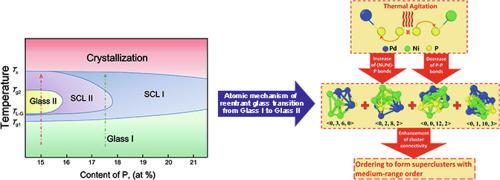当前位置:
X-MOL 学术
›
Mater. Today
›
论文详情
Our official English website, www.x-mol.net, welcomes your
feedback! (Note: you will need to create a separate account there.)
Reentrant glass transition leading to ultrastable metallic glass
Materials Today ( IF 21.1 ) Pub Date : 2020-04-01 , DOI: 10.1016/j.mattod.2019.09.002 Qing Du , Xiongjun Liu , Huiyang Fan , Qiaoshi Zeng , Yuan Wu , Hui Wang , Debaditya Chatterjee , Yang Ren , Yubin Ke , Paul M. Voyles , Zhaoping Lu , Evan Ma
Materials Today ( IF 21.1 ) Pub Date : 2020-04-01 , DOI: 10.1016/j.mattod.2019.09.002 Qing Du , Xiongjun Liu , Huiyang Fan , Qiaoshi Zeng , Yuan Wu , Hui Wang , Debaditya Chatterjee , Yang Ren , Yubin Ke , Paul M. Voyles , Zhaoping Lu , Evan Ma

|
Abstract Polyamorphs are often observed in amorphous matters, and a representative example is the reentrant glass transition in colloid systems. For metallic amorphous alloys, however, the cases reported so far are limited to metallic glasses (MGs) that undergo electronic transitions under gigapascal applied pressure, or the presence of two liquids at the same composition. Here we report the first observation of a reentrant glass transition in MGs. This unusual reentrant glass transition transforms an MG from its as-quenched state (Glass I) to an ultrastable state (Glass II), mediated by the supercooled liquid of Glass I. Specifically, upon heating to above its glass transition temperature under ambient pressure, Glass I first transitions into its supercooled liquid, which then transforms into a new Glass II, accompanied by an exothermic peak in calorimetric scan, together with a precipitous drop in volume, electrical resistance and specific heat, as well as clear evidence of local structural ordering on the short-to-medium-range scale revealed via in-situ synchrotron X-ray scattering. Atomistic simulations indicate enhanced ordering of locally favored motifs to establish correlations in the medium range that resemble those in equilibrium crystalline compounds. The resulting lower-energy Glass II has its own glass transition temperature higher than that of Glass I by as much as 50 degrees. This route thus delivers a thermodynamically and kinetically ultrastable MG that can be easily retained to ambient conditions.
中文翻译:

导致超稳定金属玻璃的重入玻璃化转变
摘要 在无定形物质中经常观察到多晶型物,其中一个代表性的例子是胶体系统中的折返玻璃化转变。然而,对于金属非晶合金,迄今为止报道的案例仅限于金属玻璃 (MG),它们在千兆帕施加的压力下发生电子跃迁,或者存在两种相同成分的液体。在这里,我们报告了对 MG 中折返玻璃化转变的首次观察。这种不寻常的折返玻璃化转变将 MG 从其淬火状态(玻璃 I)转变为超稳定状态(玻璃 II),由玻璃 I 的过冷液体介导。具体而言,在环境压力下加热至其玻璃化转变温度以上时, Glass I 首先转变为过冷液体,然后转变为新的 Glass II,伴随着量热扫描中的放热峰,以及体积、电阻和比热的急剧下降,以及通过原位同步加速器 X- 揭示的中短程尺度局部结构有序的明确证据射线散射。原子模拟表明局部偏好基序的增强排序,以在中等范围内建立相关性,类似于平衡结晶化合物中的相关性。由此产生的低能量玻璃 II 的玻璃化转变温度比玻璃 I 高 50 度。因此,这条路线提供了一种热力学和动力学超稳定的 MG,可以很容易地保持在环境条件下。以及通过原位同步加速器 X 射线散射揭示的中短程局部结构有序的明确证据。原子模拟表明局部偏好基序的增强排序,以在中等范围内建立相关性,类似于平衡结晶化合物中的相关性。由此产生的低能量玻璃 II 的玻璃化转变温度比玻璃 I 高 50 度。因此,这条路线提供了一种热力学和动力学超稳定的 MG,可以很容易地保持在环境条件下。以及通过原位同步加速器 X 射线散射揭示的中短程局部结构有序的明确证据。原子模拟表明局部偏好基序的增强排序,以在中等范围内建立相关性,类似于平衡结晶化合物中的相关性。由此产生的低能量玻璃 II 的玻璃化转变温度比玻璃 I 高 50 度。因此,这条路线提供了一种热力学和动力学超稳定的 MG,可以很容易地保持在环境条件下。由此产生的低能量玻璃 II 的玻璃化转变温度比玻璃 I 高 50 度。因此,这条路线提供了一种热力学和动力学超稳定的 MG,可以很容易地保持在环境条件下。由此产生的低能量玻璃 II 的玻璃化转变温度比玻璃 I 高 50 度。因此,这条路线提供了一种热力学和动力学超稳定的 MG,可以很容易地保持在环境条件下。
更新日期:2020-04-01
中文翻译:

导致超稳定金属玻璃的重入玻璃化转变
摘要 在无定形物质中经常观察到多晶型物,其中一个代表性的例子是胶体系统中的折返玻璃化转变。然而,对于金属非晶合金,迄今为止报道的案例仅限于金属玻璃 (MG),它们在千兆帕施加的压力下发生电子跃迁,或者存在两种相同成分的液体。在这里,我们报告了对 MG 中折返玻璃化转变的首次观察。这种不寻常的折返玻璃化转变将 MG 从其淬火状态(玻璃 I)转变为超稳定状态(玻璃 II),由玻璃 I 的过冷液体介导。具体而言,在环境压力下加热至其玻璃化转变温度以上时, Glass I 首先转变为过冷液体,然后转变为新的 Glass II,伴随着量热扫描中的放热峰,以及体积、电阻和比热的急剧下降,以及通过原位同步加速器 X- 揭示的中短程尺度局部结构有序的明确证据射线散射。原子模拟表明局部偏好基序的增强排序,以在中等范围内建立相关性,类似于平衡结晶化合物中的相关性。由此产生的低能量玻璃 II 的玻璃化转变温度比玻璃 I 高 50 度。因此,这条路线提供了一种热力学和动力学超稳定的 MG,可以很容易地保持在环境条件下。以及通过原位同步加速器 X 射线散射揭示的中短程局部结构有序的明确证据。原子模拟表明局部偏好基序的增强排序,以在中等范围内建立相关性,类似于平衡结晶化合物中的相关性。由此产生的低能量玻璃 II 的玻璃化转变温度比玻璃 I 高 50 度。因此,这条路线提供了一种热力学和动力学超稳定的 MG,可以很容易地保持在环境条件下。以及通过原位同步加速器 X 射线散射揭示的中短程局部结构有序的明确证据。原子模拟表明局部偏好基序的增强排序,以在中等范围内建立相关性,类似于平衡结晶化合物中的相关性。由此产生的低能量玻璃 II 的玻璃化转变温度比玻璃 I 高 50 度。因此,这条路线提供了一种热力学和动力学超稳定的 MG,可以很容易地保持在环境条件下。由此产生的低能量玻璃 II 的玻璃化转变温度比玻璃 I 高 50 度。因此,这条路线提供了一种热力学和动力学超稳定的 MG,可以很容易地保持在环境条件下。由此产生的低能量玻璃 II 的玻璃化转变温度比玻璃 I 高 50 度。因此,这条路线提供了一种热力学和动力学超稳定的 MG,可以很容易地保持在环境条件下。











































 京公网安备 11010802027423号
京公网安备 11010802027423号